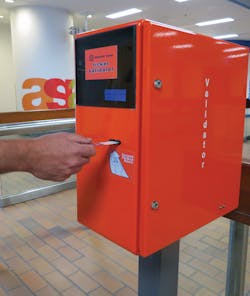Pilot of Radiological and Explosives Detection System Completed in Edmonton
Cubic Security Systems recently completed a Canadian government pilot at Churchill light-rail transit station in Edmonton, Alberta, to evaluate new radiological and explosives detection technologies for public transit security. The Clear-Use radiological and explosives detection system developed by Cubic Security Systems and prime contractor Mobile Detect Inc. of Ontario was used in the pilot.
According to Walt Bonneau Jr., president of Cubic Security Systems, the Clear-Use detection system integrates both radiological and explosives sensors into public transit fare collection equipment in a manner that is non-intrusive to the traveling public. "In the case of the Edmonton system, the explosives detection, using molecularly imprinted polymers (MIPs) deposited as a thin film, was integrated into the ticket validating machine and the radiological detection was integrated into the ticket vending machine," he says. "The two sensor systems worked together to detect not only explosives and radiological threat materials, but also the combination that could be used to create a 'dirty bomb.'"
Bonneau says all resulting detection data was communicated to a back-end command and control system. Detection occurrences were also reported via secured smartphone BlackBerrys to the transit peace officers. If an explosive detection occurs, a silent alert is sent to the back-end command and control center for further response.
"The radiological sensors are standoff sensors that are capable of detecting and differentiating medical from threat radiological matter," he says. "When radiological threat detection occurs, the type of radiological material is sent along with a silent alert to the command and control center. The Clear-Use system is also capable of sending images of the person interacting with the fare collection system, but only if a detection event occurs."
Pilot Evaluation in Edmonton
The purpose of the pilot evaluation was twofold, according to Bonneau. First, to see if a detection security system could be deployed in a public transit system that would not become intrusive to the public's normal traveling experience, and secondly, to prove that the detection technology would actually detect such threat substances.
"The overall pilot was successful and both the explosives and radiological testing backed that up," he says. "However, additional testing is planned in the lab to further improve the level of detection. In addition, the ticket validating units are having minor ticket handling modifications made to handle multiple types of tickets, not just one ticket type as originally planned."
The pilot had multiple positive aspects, according to Bonneau. The detection equipment was well supported by the Edmonton Transit peace officers, who interacted with the system effectively. Deploying the detection equipment in an existing transit system caused little interruption to operations, and the equipment was well integrated into the existing equipment, which significantly minimized the need to have the public relearn how best to use the system.
"Actual test-driven detections occurred as planned and the back-end command and control system worked flawlessly," he says. "The ticket validating unit is being modified to accommodate more ticket types with improved tolerance for badly damaged paper tickets, which occurs periodically in any transit system."
More to Come
Bonneau says that Cubic is already working on additional deployment plans in North America. The company is interested in additional deployments in Canadian transport systems and learning lessons from the Edmonton pilot evaluation will aid in making future evaluations run even more smoothly.
"The cooperation given by the Edmonton Transit team was outstanding and highly supportive," he says. "The foresight and support of the Canadian Government CRTI (Chemical, Biological, Radiological and Nuclear (CBRN) Research and Technology Initiative, now (CSSP) Canadian Safety and Security Program) made this possible. If there was one item we would change and/or request, looking back, is that more time be allocated to the in-system detection testing. This added time would have benefited the overall captured data and equipment dependability modeling, where actual traveling users were involved."
About the Author

